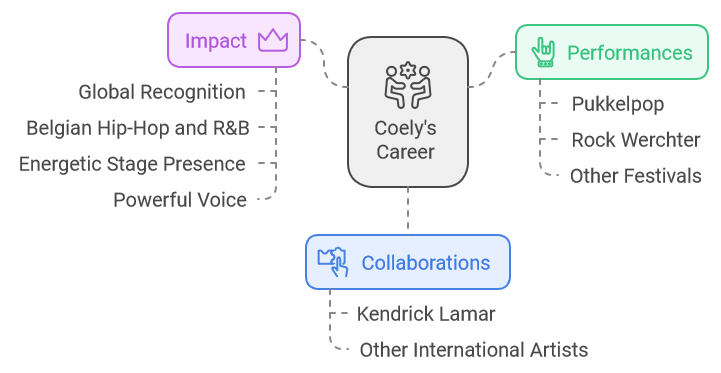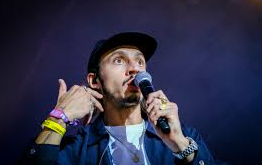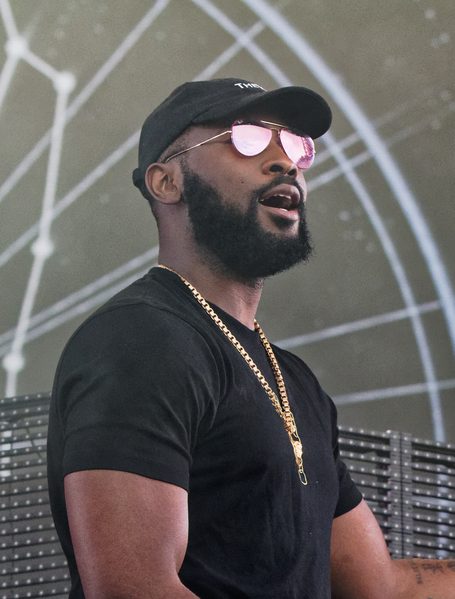In recent years, Belgium has witnessed a dynamic surge in its hip-hop scene, reflecting the country’s unique cultural diversity. Bridging the gap between its French and Dutch-speaking communities, Belgian hip-hop brings together a broad range of influences. Artists from cities like Brussels, Antwerp, and Liège have carved out distinctive sounds, drawing from both local experiences and global trends. Belgian rappers such as Damso and Roméo Elvis have gained international attention, helping put the country on the European hip-hop map. The Belgian scene stands out for its fusion of languages, with artists often rapping in French, Dutch, English, or a combination of these, allowing them to resonate across linguistic borders. Additionally, the influence of Congolese culture, brought over by the large Congolese diaspora, has significantly shaped the sound and lyrics of many Belgian rappers.
The country’s hip-hop growth parallels global movements but remains distinct in its storytelling, language fluidity, and eclectic beats, all while staying rooted in European urban life. The mix of gritty street rap and more mainstream, melodic styles has led Belgian artists to make an impact not just locally but on the broader European stage. Through collaborations with international stars and performances across Europe, Belgian hip-hop is gaining global traction.
Damso
Background:
Damso, born William Kalubi Mwamba, is one of the most celebrated figures in Belgian hip-hop. Originally from Kinshasa, Congo, he moved to Belgium at a young age. His African heritage and experiences as an immigrant have heavily influenced his music, allowing him to create a distinctive blend of introspective and socially conscious rap. His rise to fame began when he joined the rap collective 92i, led by French rapper Booba, which helped elevate his presence in the Francophone music world. Today, Damso is not just one of the most well-known rappers in Belgium but a key figure in French-language rap across Europe.
Notable Achievements:
Damso’s discography includes several critically acclaimed albums, most notably Ipséité (2017) and Lithopédion (2018), both of which dominated the Belgian and French charts. Ipséité, in particular, is considered his breakthrough, achieving double platinum status and winning him widespread recognition. With each album, Damso’s fan base expanded rapidly, with listeners resonating with his raw, emotional lyricism. His success stretches beyond just Belgium and France; he has built a strong following in other French-speaking countries and communities around the world(The Brussels Times)(Last.fm).
Lyrical Themes:
Damso’s music is characterized by its depth, with his lyrics often delving into personal struggles, identity, and existential themes. His songs frequently address the complexities of navigating life as an immigrant, systemic oppression, and the psychological challenges of fame and success. In addition to these heavy topics, Damso is known for exploring relationships, love, and the human condition, making his music relatable to a wide audience. His introspective approach has set him apart from many of his peers, elevating the lyrical sophistication in Belgian rap(The Brussels Times).
Influence:
Damso has redefined what Belgian hip-hop can achieve on the international stage. His ability to mix emotional vulnerability with hard-hitting rap has earned him a reputation as one of the most lyrically talented rappers in Europe. Beyond his music, Damso’s presence in the cultural conversation, his fashion, and his artistic choices have further solidified his influence. He is widely credited with pushing the boundaries of what it means to be a Belgian rapper, breaking into the broader Francophone rap scene, and bringing international attention to Belgian hip-hop(Last.fm).
Hamza
Hamza, often referred to as “the Belgian Drake,” is a key figure in Belgium’s hip-hop scene, known for his smooth blend of trap, R&B, and hip-hop. His versatility and ability to mix melodic hooks with hard-hitting beats have earned him significant recognition, not just in Belgium but across Europe. Hamza’s sound and lyrical style, which frequently focus on themes of love, relationships, and personal experiences, have drawn comparisons to the global superstar Drake, particularly for his ability to seamlessly transition between singing and rapping.
Musical Style:
Hamza’s music is defined by its fusion of genres, combining trap’s heavy basslines and hi-hats with the softer elements of R&B and hip-hop. His signature style blends melodic flows with catchy, laid-back beats, creating a sound that is both atmospheric and energetic. His use of Auto-Tune, layered vocals, and trap production adds a distinctive vibe to his music, appealing to fans of both rap and more mainstream pop-infused hip-hop. Hamza’s ability to move effortlessly between smooth, soulful vocals and rhythmic rap bars has helped him carve out a unique space within the Belgian and French hip-hop scenes.
Key Tracks and Influence:
Some of Hamza’s most well-known tracks include Codéine 19 and Sincèrement, both of which showcase his ability to balance introspective lyrics with catchy, chart-topping production. Codéine 19 exemplifies his trademark style—emotive, melodic, and heavily influenced by trap music’s dark, atmospheric beats. Meanwhile, Sincèrement highlights his softer side, with more R&B-infused melodies that resonate with a wide audience. These tracks, among others, have helped Hamza gain a loyal fan base in Belgium, France, and other Francophone regions, further solidifying his place as one of the leading voices in the new wave of European rap.
Role in the Scene:
As a leading figure in the trap subgenre of Belgian hip-hop, Hamza has played a significant role in pushing the boundaries of what Belgian rap can sound like. His unique sound—merging trap with R&B—has influenced a new generation of Belgian artists, as well as the broader Francophone rap scene. Hamza’s success has also paved the way for greater recognition of Belgium’s hip-hop talent, showing that Belgian artists can make a significant impact on the international stage. His ability to blend emotional depth with mainstream appeal has made him a central figure in shaping the modern trap sound in Belgian rap(The Brussels Times)(Last.fm).

Coely
Coely stands out in the Belgian hip-hop scene for her ability to seamlessly fuse rap with elements of soul, R&B, and pop. Her sound is a powerful blend of genres, showcasing her versatility as an artist. Known for her commanding vocal range, she effortlessly switches between rapping and singing, creating a dynamic performance that captivates audiences. What truly sets Coely apart is her multilingualism. She frequently performs in English, Dutch, French, and Lingala, a nod to her Congolese roots. This ability to blend multiple languages not only enhances her sound but also broadens her appeal to a diverse audience both in Belgium and internationally.
Crossover Appeal:
Coely’s ability to perform in multiple languages allows her music to resonate with a wide and varied audience. By incorporating English, Dutch, French, and Lingala into her songs, she crosses cultural and linguistic boundaries, making her music accessible to people from different backgrounds. This mix of languages also reflects Belgium’s own cultural diversity, allowing her to connect with both the French-speaking and Dutch-speaking communities in her home country. Additionally, her use of Lingala ties her music to her African heritage, adding depth and authenticity to her sound and expanding her appeal to the African diaspora.
Major Collaborations and Performances:
Coely has earned widespread recognition, not only for her solo work but also through high-profile collaborations and performances. She has shared the stage with major international artists, including Kendrick Lamar, which has helped elevate her profile on the global music scene. Her performances at renowned festivals like Pukkelpop and Rock Werchter have solidified her reputation as a standout performer, known for her energetic stage presence and powerful voice. These major opportunities have allowed Coely to showcase her talent to larger audiences, further establishing her as a leading figure in Belgian hip-hop and R&B.
Caballero & JeanJass
Caballero & JeanJass are one of the most beloved duos in the Belgian hip-hop scene, known for their clever wordplay, witty lyrics, and undeniable chemistry. Their unique blend of humor and sharp lyricism has made them staples in Belgian rap, attracting fans with their laid-back yet engaging style. The two rappers, Caballero (real name Ivan Lurkin) and JeanJass (real name Jean-Jasmin Van Hamme), joined forces in 2016, and their collaborative work quickly became a favorite among Belgian and French-speaking audiences. Together, they create music that feels fresh, light-hearted, and accessible, while still maintaining the lyrical depth expected in hip-hop.
Collaborative Style:
The duo’s partnership is marked by a natural synergy, with Caballero’s introspective style balancing JeanJass’ more comedic and light-hearted approach. Their chemistry shines through in tracks like Californie, where they exchange playful bars over smooth, catchy beats. This song, and many others, highlight their ability to mix serious commentary with humor, making their music both entertaining and thought-provoking. Their collaborative albums, such as Double Hélice series, have been especially popular, allowing them to appeal to audiences in both Belgium and France. The duo’s versatility, from light trap beats to deeper lyrical explorations, keeps their fan base loyal and ever-growing.
Contribution to Belgian Rap:
Caballero & JeanJass have played a pivotal role in keeping the Belgian rap scene lively and innovative. Their creativity and humor infuse the Belgian hip-hop landscape with a distinct personality, setting them apart from other artists. By mixing sharp wit with high-energy performances, they offer a refreshing take on the genre, ensuring that their music stands out in a competitive market. Their contributions go beyond just music; they’ve also become cultural icons in Belgium, expanding their influence through interviews, web series, and other creative projects. With their continued success, Caballero & JeanJass remain integral to the evolution of Belgian hip-hop, proving that humor and creativity are just as essential as hard-hitting bars.
Green Montana
Green Montana is a rapidly rising star in the Belgian hip-hop scene, known for his unique melodic trap sound. Signed to the prestigious French label 92i, which is led by French rap icon Booba, Green Montana has quickly become one of the most exciting names to watch in European hip-hop. His signing to 92i not only showcases his talent but also aligns him with a label known for pushing some of the most influential voices in French rap, further elevating his profile within the industry.
Melodic Trap Style:
Green Montana is particularly known for his dreamy, melodic flow that sets him apart from many of his contemporaries. His music leans heavily on atmospheric beats and melodic trap rhythms, creating a laid-back yet emotionally resonant sound. This combination of smooth melodies with trap elements has allowed him to craft a style that is both accessible and introspective, appealing to listeners who enjoy the melodic elements of rap but still want the intensity of trap. His use of Auto-Tune and laid-back delivery complements the beats, giving his music a moody, reflective vibe that’s been gaining attention rapidly across the hip-hop industry.
Notable Tracks:
Among Green Montana’s growing catalog, the track Méfiant stands out as one of his most popular songs. This track encapsulates his signature style, blending a mellow, melodic delivery with darker, introspective lyrics. Méfiant has resonated with a younger generation of listeners, showcasing Green Montana’s ability to speak to personal themes while maintaining a mainstream appeal. His music’s influence is already visible among emerging Belgian and French rappers who are adopting similar melodic trap styles, proving that Green Montana is helping to shape the future of the genre.

Roméo Elvis
Key Player in Belgian Rap:
Roméo Elvis has emerged as a significant figure in the Belgian hip-hop scene, known for his innovative blend of electronic beats and rap fusion. His unique sound is characterized by a combination of traditional hip-hop elements and contemporary electronic influences, making him a standout artist in the genre. This fusion has helped him carve out a niche that resonates with a diverse audience, contributing to his status as one of the key players in Belgian rap.
Collaboration with Le Motel:
A pivotal aspect of Roméo Elvis’s sound is his collaboration with producer Le Motel, whose electronic production style complements Elvis’s laid-back rap delivery. Together, they have crafted several tracks that showcase their chemistry, with Le Motel’s atmospheric beats providing a perfect backdrop for Roméo’s introspective and relatable lyrics. This partnership has resulted in critically acclaimed projects that have helped shape Roméo’s distinctive sound, setting him apart in the competitive landscape of Belgian hip-hop.
Fanbase and Influence:
Roméo Elvis has developed a broad fanbase across Europe, drawing listeners with his chill, laid-back lyrical style. His music often explores themes of everyday life, relationships, and personal reflections, resonating with a wide audience and earning him recognition beyond Belgium. His influence is evident in the growing number of emerging artists who cite him as an inspiration, particularly those looking to blend rap with other musical genres. As he continues to release new music, Roméo Elvis remains a vital force in the evolution of Belgian hip-hop, showcasing the genre’s potential for innovation and cross-cultural appeal(The Brussels Times)(Last.fm).
Conclusion
In summary, the diverse array of artists highlighted—Damso, Hamza, Coely, Caballero & JeanJass, Green Montana, and Roméo Elvis—each play a significant role in enriching the Belgian hip-hop landscape. Their unique styles and contributions reflect the genre’s versatility, from introspective and lyrical depth to catchy, melodic trap beats. This variety showcases how Belgian hip-hop is not only a cultural expression but also a dynamic musical force that resonates with different audiences.
Furthermore, Belgian hip-hop is thriving not just locally but also making its mark on the global stage. Artists like Damso and Hamza have crossed borders, gaining recognition in France and beyond, while others are influencing a new wave of rappers across Europe. The impact of these artists indicates that Belgian hip-hop is poised to continue its ascent, shaping and redefining the genre on an international level(The Brussels Times)(Last.fm).
FAQs
1. Who is the most popular Belgian hip-hop artist? Damso is often regarded as one of the most popular Belgian hip-hop artists, known for his introspective lyrics and impactful albums like Ipséité and Lithopédion. His widespread fan base extends beyond Belgium to France and other Francophone regions(The Brussels Times)(Last.fm).
2. What defines the musical style of Hamza? Hamza is known for his fusion of trap, R&B, and hip-hop, often referred to as “the Belgian Drake.” His catchy beats and melodic flows make his music appealing to a broad audience(The Brussels Times)(Last.fm).
3. How does Coely incorporate multiple languages into her music? Coely performs in English, Dutch, French, and Lingala, which enhances her accessibility to a diverse audience and reflects Belgium’s multicultural landscape(The Brussels Times).
4. What impact have Caballero & JeanJass had on Belgian hip-hop? Caballero & JeanJass are recognized for their witty lyrics and engaging style, keeping the Belgian rap scene lively with their humor and creativity. Their collaborations have produced popular tracks like Californie(The Brussels Times)(Last.fm).
5. How has Green Montana influenced the younger generation of rappers? Green Montana’s dreamy, melodic trap style has gained significant attention, with tracks like Méfiant resonating with younger audiences. His sound is inspiring emerging Belgian and French rappers to explore similar musical directions(The Brussels Times)(Last.fm).
6. What role does Roméo Elvis play in the Belgian hip-hop scene? Roméo Elvis is a key player known for blending electronic beats with rap. His collaborations with producer Le Motel have shaped his unique sound, making him influential in both the Belgian and broader European hip-hop landscape(The Brussels Times)(Last.fm).
7. How is Belgian hip-hop making an impact globally? Belgian hip-hop artists are gaining recognition not only in their home country but also across Europe and beyond. Artists like Damso and Hamza are paving the way for a new wave of Belgian hip-hop that is increasingly resonating with international audiences(The Brussels Times)(Last.fm).
